
Situated a short walk outside of Jerusalem’s stone walls is the excavation site for the biblical city of Jewish kings. The dig enfolds into a safari experience for the “City of David.” Visitors can take a guided tour, as I did, to explore the mystic past that today falls past the Green Line. Other options include an East Jerusalem Segway ride into the time of great Jewish kings, or a paintball fight. The peace talks may be floundering, but the “City of David” in occupied Jerusalem is flourishing.
The park is run by the Elad organization, a quasi-governmental group that has the sole privilege in Israel of being both a private entity and a municipal authority. In Jerusalem it functions akin to the Disney Corporation in Florida, except with religious calibrations at play to determine who are the newest residents.
Standing in the ancient city ruins, Raphael, my guide from Elad, explained, “No more than 3,000 people could live there.” Despite its meager population, the historical City of David and the present day biblical park of David are an ever expanding behemoth with a second visitor center under construction and metal gates with turnstiles and entrance fees to keep out the Palestinian Jerusalemites of Silwan, the neighborhood that the City of David is built inside of, or more specifically on top of.
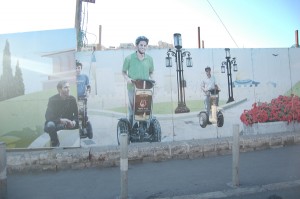
Today Silwan is in a losing plus-minus relationship with the far past. The City of David bible park runs an archeological dig that is literally underneath Palestinians houses. The tunnels are like a basement owned by a different tenant, only less structurally sound for the homes above. The tunnels have caused cracks in the Palestinian houses.
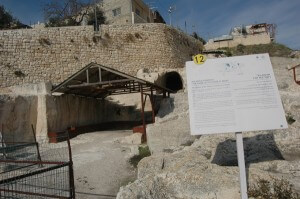
Three months ago when the City of David expanded its heritage site to shows off new ruins for tourists, it came at the expense of the Palestinian neighborhood. The latest construction project was a stone promenade with numbered plaques detailing how the sites are historically important. But before the promenade was a field where Palestinian children played soccer. And to the south is a metal barred crossing that locks at night. The bible park has privatized land once zoned as Palestinian agricultural territory. Yet with Elad in city positions, the private organization was able to re-zone it as a national park, and then came the privatized entrance to the park.
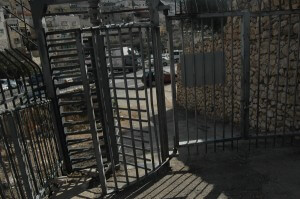
Back on the three-hour tour our second stop was a cramped screening room equipped with a 15-minute video. “With the help of a shovel, and with the help of the bible,” said Amos, a 3-D Israeli-accented talking head dressed in a khaki vest and cowboy hat.
The “crowning moment” of this Jewish kingdom, Amos said, was the Temple Mount. But sadly, warfare was prophesied and “Israel” fell to enemies like the Assyrians and the Babylonians.
Cue the timpani again, pounding over the violins in minor scale. It was the kind of music that foreshadows paranormal activity.
“Can you hear the Babylonian forces laying siege to the city?” asked Amos. Something jumped out at us from the screen. Maybe a sword, but I couldn’t tell because the fast movements made me nauseous and I dropped my glasses on the ancient floor of the viewing room. This historical adventure was too extreme for me. “For 2000 years the city passed from hand to hand,” continued Amos, cutting out 2000 years of history from the time of King David until 1948.
Cut to the violins again, a song of redemption.
Underground the tour continued towards the earth’s core. A group of female soldiers passed us. Modernity and antiquity collided. I wondered if they were on a tour too, or if they are just moving through the museum to get to lower Silwan. The City of David bible park is also the main throughway on foot to the Palestinian neighborhood. The soldiers with long hair tied back in tortoise shell clips could be an exhibit also.
Raphael then led us through a round of once tunnels that he said only filled and flowed with water as a fail-safe when the city was under siege. Jerusalem, through the eyes of Elad, is a tale of conquest and fighting. Never mind the 2000-year historical gap. “Looked at the shaft!” he yelled to us. It was an ancient, natural shaft and now we could see it because of the bible park.
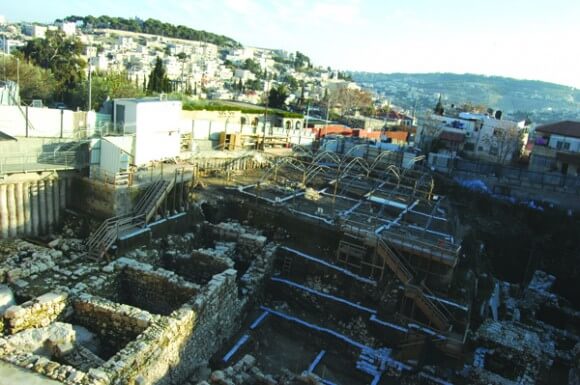
Outdoors again Raphael directed us to the spring of Shiloh where I met my first Palestinians inside of the range. I first visited the City of David/Silwan more than a year ago. Its expansion over 14 months is wild. One of the most striking differences is that on my inaugural trip Palestinian children ran through the shared streets of the modern-day city of Silwan and modern day theme park. But now these paths are cluttered with tourists. No children to be found. Across the valley we gazed at Palestinian Silwan. “Look how horrible their houses are,” said one of my fellow tourists, a middle-age man from New York accompanied by his wife and despondent teenage son.
“I used to stand here with one of the archeologists” said Ismail Kanan, 49, the only visible Palestinian walking around the park. He slapped the hand of an Israeli Elad guide who greeted him cheerfully in Arabic. “You can’t be enemies with everyone,” noted Kanan.
Kanan used to work for the City of David from 2004 to 2009, but quit after he witnessed the shady business of Elad backed home evictions. “There was some work that went on without permits,” he said. Kanan explained in the past other Palestinians also were employed with the City of David, but everyone left after they realized that bible park was going to be built on top of their homes.
Still, Kanan remains in the archeological business. He leads his own tours through the City of David, groups he meets from churches, or friends of friends. His main gripe against the City of David today is that they skip over Muslim and Christian history. Kanan then pointed to the blue wristbands of my tourists group led by Raphael “They show just the time of Zedekiah and David, not the Palestinian people, or the Christians, or the Muslims.”
Kanan and I watched a shuttle van scoop up my tour group and drive them back to the top of the hill so they would not have to walk through the Palestinian area to return to the starting point. Then Kanan and I ventured south where he introduced me to Khalid Azir, Silwan’s most famous resident and cave dweller.
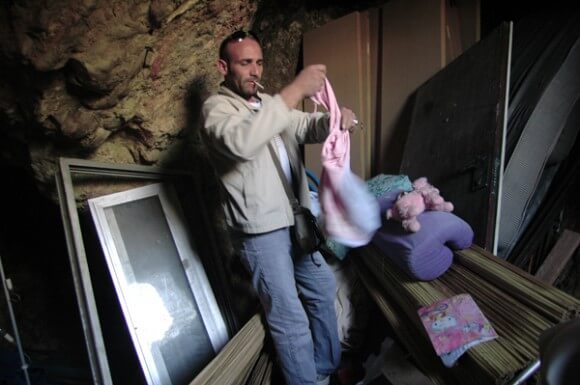
Azir father was born in one of Silwan’s many caves. He was raised in a house in front of the cave, where Azir had been living with his wife and six children until four months ago when an Israeli bulldozer arrived and destroyed everything in a matter of minutes. Azir’s house was constructed without a permit, but he was paying off the municipality for a stay of demolition. Unfortunately the stays didn’t hold and the house was reduced to rubble just before sunrise last fall.
With few options, Azir, his wife, and his six children moved into the cave. “People came and took pictures, but no one helped.” After three weeks a doctor recommended he relocate the children indoors with relatives because they had fallen ill from the elements. Yet Azir stayed on in the cave. He collected his children’s toys from the demolition rubble, showing me a stuffed animal and a blanket. Two months ago he built a small room out of wood doors in front of the cave’s entrance. Now it too has a demolition order.
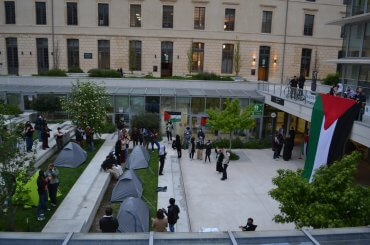

I confess that I did this tour a few years ago. It’s impressive and very political. With a h/t to Seafoid: the Disneyfication of Israel continues full steam ahead. In the good old days, when I was a kid, we would wander through the Silwan waterway. I suppose as Israeli Jews we were not welcome guests. Still, we were kids and we weren’t carrying guns. The site then was completely undeveloped. It was wonderful to get down there in the boiling summer and walk through the icy water.
Now, it is a fortress with security cameras and guards, walls and turnstiles. It’s an odd combination of privatization and settler colonization. Like a cruise’s private beach in Haiti. Carribean paradise fenced off from Haitian misery. But also like a settlement, fenced in with technology, protected by the army and armed settlers.
Other sites have gone through the same kind of commercialization and are used as tools of indoctrination. I used to play in the blown up bunkers and trenches of the Castel fortress just west of Jerusalem. I remember balancing on a huge concrete slab that was hanging by a couple of metal rods. It was quite unsafe and there were no fences barring my entry. I would imagine the battles in 1948 between the Jewish and Arab forces. Today it is a national (Jewish) monument. It is safe and official and has become a tool of indoctrination. You are told exactly what to think.
I’m sure the soldiers you saw there were on some tour of indoctrination, a key function of Israeli military service.
Btw, it is “Shiloah”. “Shiloh” is to the north and is unrelated.
The park is run by the Elad organization, a quasi-governmental group that has the sole privilege in Israel of being both a private entity and a municipal authority.
The JNF and WZO have also cut deals that allow them to engage in the same racket. Even though it is a private company, the JNF has a special public status because it has statutory authority over forestry. By law, the JNF also has a hand in controlling all national planning done by the Israel Land Authority Council and its employees are considered public employees. The WZO has the same sort of set-up for its Settlement Division in the Prime Minister’s office.
*JNF could be subject to state comptroller review if Israel’s justice ministry has its way: The Jewish National Fund, which is registered as a private company even though its assets are state lands, spends billions subject to no government oversight.
http://www.haaretz.com/news/national/.premium-1.537798
* Livni to impose freedom of information act on WZO settlements division
http://www.jpost.com/Diplomacy-and-Politics/Livni-to-impose-freedom-of-information-act-on-WZO-settlements-division-322071
Alisson is still unable to do it. She almost did but could not go the extra yard needed. She could not bring herself to say that the sites in the City of David are mentioned in the Bible. All of the archaeology in the area Alisson visited has to do with Jewish history. It has nothing to do with Palestinian history. There are Arab homes on street level and there are no items of archeological interest with these homes, many of which where built during the last 100 years. Jews have a long and significant history here. Don’t you think it is about time that you reconcile yourself with this fact Allison? This is what is needed if peace is ever to happen.
There is no Jewish or Palestinian history, only history. The continuity implied by such expressions is delusory. Suppose, giladg, that you were transported back to the times of David or Solomon in a time machine. You would feel that you were in a very strange land. And the ancient Israelites would find you very strange too. You would probably get stoned to death as some sort of sorcerer.
Fortunately for Jews, and I am talking about those Jews who are aware of their history and heritage and feel no need to apologize for it, there is a direct connection going back to the times of David and Solomon. The language, the Torah, the Psalms of David and the verbal history, all contribute to this connection. Maybe Stephen can tell us of another people besides the Jews who live in this region and speak the same language (or very similar) to what was spoken over 2,000 years ago? So if anyone went back to biblical times the Jews are one people who have more in common than most. The Palestinians would certainly not. Arabic came about 1,400 years ago which is recent history compared to that of the Jews.